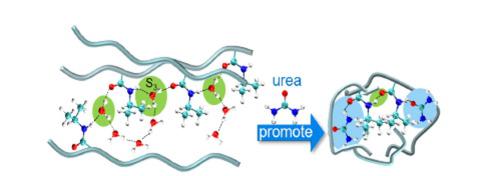Spectrochimica Acta Part A: Molecular and Biomolecular Spectroscopy ( IF 4.3 ) Pub Date : 2021-02-13 , DOI: 10.1016/j.saa.2021.119573 Biao Ma , Li Wang , Li Han , Wensheng Cai , Xueguang Shao

|
Regulating the folding state by denaturants is essential for the structure and function of proteins. Poly(N-isopropyl acrylamide) (PNIPAM) is usually regarded as a model for protein denaturation. The effects of urea, as a denaturant, on the aggregations of PNIPAM was studied by temperature-dependent near-infrared (NIR) spectroscopy, and particularly the variation of water structures was analyzed. The NIR spectra of the polymer-urea solutions containing different polymer concentrations were measured at different temperatures. N-way principal component analysis (NPCA) was performed to observe the spectral information. Three principal components (PCs) containing the spectral information of CH groups were obtained, showing three kinds of CH in the system. Obvious dehydration of the three CH groups occurs at 27.5 °C in solution, but the temperature turns to 27 °C for two kinds of the CH and 26.5 °C for the third one, respectively, in the urea-add solution. The effect of urea on the formation of the intramolecular hydrogen bonds that promotes polymer folding is suggested. The spectral information of NH in urea molecule indicates that the direct interaction of urea and polymer facilitates the stability of the polymer globule state. Furthermore, the spectral information of OH shows that the release of the water molecules with three hydrogen bonds (S3), which may connect the NH and CO groups in PNIPAM in solution, leads to the phase transition. When urea is added, urea may reduce the content of the S3 water to facilitate the release, making the phase transition at a low temperature.
中文翻译:

通过温度依赖性近红外光谱了解尿素对水溶液中聚N-异丙基丙烯酰胺的相变的影响
通过变性剂调节折叠状态对于蛋白质的结构和功能至关重要。聚(N-异丙基丙烯酰胺)(PNIPAM)通常被认为是蛋白质变性的模型。通过温度依赖性近红外(NIR)光谱研究了尿素作为变性剂对PNIPAM聚集体的影响,特别是分析了水结构的变化。在不同温度下测量了含有不同聚合物浓度的聚合物-尿素溶液的近红外光谱。进行N向主成分分析(NPCA)以观察光谱信息。获得了包含CH基团光谱信息的三个主成分(PC),显示了系统中的三种CH。在溶液中27.5°C时,三个CH基团明显发生脱水,但是在添加尿素的溶液中,两种CH的温度分别变为27°C,第三种CH的温度变为26.5°C。提出了脲对促进聚合物折叠的分子内氢键形成的影响。尿素分子中NH的光谱信息表明,尿素与聚合物的直接相互作用促进了聚合物球状态的稳定性。此外,OH的光谱信息表明具有三个氢键的水分子的释放(S 尿素分子中NH的光谱信息表明,尿素与聚合物的直接相互作用促进了聚合物球状态的稳定性。此外,OH的光谱信息表明具有三个氢键的水分子的释放(S 尿素分子中NH的光谱信息表明,尿素与聚合物的直接相互作用促进了聚合物球状态的稳定性。此外,OH的光谱信息表明具有三个氢键的水分子的释放(S3)可能会连接溶液中PNIPAM中的NH和CO基团,导致相变。当添加尿素时,尿素可以减少S 3水的含量以促进释放,从而在低温下发生相变。











































 京公网安备 11010802027423号
京公网安备 11010802027423号